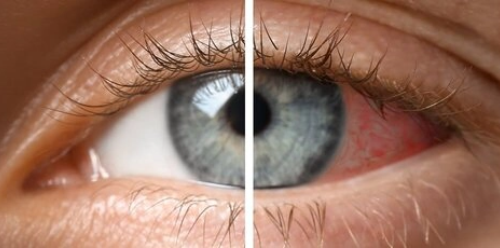Macular Degeneration
Exploring AAGP®’s potential to reverse retinal damage and vision loss
According to the National Eye Institute, age-related macular degeneration (AMD) is a disease often occurring in older people, involving damage to the macula (the focal center of the eye responsible for “20/20” color vision), which can affect the central vision required for daily activities, such as reading, cooking and driving.
Macular degeneration is a common condition and the leading cause of vision loss in people over the age of 50. It can occur quickly or slowly over time and may affect one or both eyes. Macular degeneration affects central vision, or what you see when you look straight ahead. It does not have an effect on peripheral vision, so it does not cause total blindness.

The causes of macular degeneration
Behind our eyes is a complex network of rods, cones and vessels. Macular degeneration occurs when the central portion of the retina deteriorates, leading to irreversible vision loss over time. A healthy macula captures detailed images from the center of the field of vision and sends them to the brain via the optic nerve. The macula is designed to prioritize the data our eyes capture. As macular degeneration progresses, these images become blurry and distorted.
Dry, or atrophic, macular degeneration occurs when drusen (small, yellow deposits) develop under the macula. It is the most common form of the disease, occurring in about 85 to 90% of patients, according to the American Macular Degeneration Foundation. Wet, or exudative, macular degeneration affects about 10 to 15% of patients and occurs when abnormal blood vessels develop under the retina and macula.
The symptoms of macular degeneration
Affecting more than 10 million Americans – more than cataracts and glaucoma combined – macular degeneration is currently considered the number one cause of vision loss. No matter the form of macular degeneration, common symptoms include:
- A blurry, dark spot in your field of vision
- Blurred or hazy vision
- Distortion and deterioration of central vision
- Need for brighter lighting and difficulty adjusting to dim environments
- Rapid central vision loss
- Trouble seeing and recognizing faces
Treatments for macular degeneration
There are currently no known cures for macular degeneration, but there are options to potentially help slow the progression of the disease. Rehabilitation specialists can help patients cope with vision loss, and surgery could be used to magnify fields of vision with telescopic lenses. Laser treatments may be recommended for wet macular degeneration, as they can be used to treat leaking or abnormal blood vessels. Unfortunately, these treatments may cause permanent scarring and often require multiple treatments.

AAGP® as a potential solution
With AAGP®, our proprietary anti-aging glycopeptide, ProtoKinetix researchers are investigating ways in which cell preservation can be utilized to help reverse retinal damage associated with macular degeneration and potentially even restore vision. AAGP® has shown early potential to help improve success rates in retinal cell transplants by aiding in cell survival over time.
ProtoKinetix research and clinical trials
Led by world-renowned ophthalmologist, Dr. Kevin Gregory-Evans, pre-clinical trials investigating AAGP® in potential treatments for macular degeneration have been undertaken. We are currently in stage 3 of our pre-clinical retinal replacement program with extremely promising results thus far. Read our recent press releases to see where our research is at today and what’s coming next:
Market potential for macular degeneration
While our research progress has been extremely positive, we need the support of dedicated investors to continue exploring the potential cell-saving effects of AAGP® for macular degeneration. The global macular degeneration market is expected to reach $8.9 billion by 2022, due to the aging population, growing prevalence of chronic diseases and increasing health care costs. The opportunity is immense, and we hope you’ll join us on this journey.
Applications of AAGP® in Ophthalmology

According to the Mayo Clinic, dry eye disease occurs when our bodies cannot produce enough tears to adequately lubricate our eyes. This can result in discomfort, itching, stinging, burning and even vision problems.

In addition to other complications, diabetes can adversely affect the eyes by causing diabetic retinopathy, or damage and deterioration of the blood vessels in the retina. In fact, diabetic retinopathy is the number one cause of blindness in young adults, according to the American Academy of Family Physicians.

Sjogren’s syndrome is an autoimmune condition in which a body’s own immune system attacks the cells in the moisture-producing salivary glands and tear ducts. The outcome of this autoimmune response is painfully dry eyes and mouth.

Uveitis is an inflammation of the uvea, or eye wall—the middle layer of tissue of the eye. Whereas conjunctivitis affects the outer layer of the eye, uveitis affects the interior of the eye in the front, middle, or back of the organ.

Research Pipeline for Ophthalmology:
Research:
Development:
We are in stage-3 of our pre-clinical retinal replacement program. The Gregory-Evans Retinal Therapeutic Lab at The University of British Columbia is testing whether AAGP® treated cells continue to develop into retinal cells. If successful, this could lead to the restoration of vision in humans. For example, retinal cell replacement therapy could become a critical approach for the treatment of retinal diseases including Age-Related Macular Degeneration (AMD).
Research:
Development:
Dry eye disease afflicts more than 30 million people in America and 430 million people around the world. We’re going to look into the effects of AAGP® on ocular inflammation when applied topically. With this biotechnology, we’re hoping to improve the quality of tears that lubricate and nourish the eye. This will help the hundreds of millions of people affected by this chronic issue.
Veterinary treatments
Research:
Development:
It’s possible that you don’t suffer from dry eye or other eye conditions, but your pets do. We plan on researching AAGP® in veterinary treatments. As we move through the discovery phase, we’ll narrow down our line of exploration to find out how we can improve ophthalmology care in animals.
Explore other Industry applications for AAGP®
If you’re interested in supporting our macular degeneration research while you support your financial future, contact your broker or reach out to the team at ProtoKinetix to learn about investment options.


